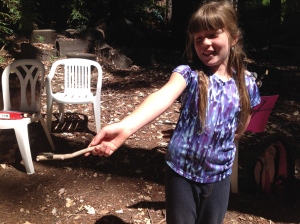One of the things that struck me about the Community Music School of Santa Cruz structures its Kids’ Trad Music Day Camp was just how much free time the students had during the day.
Our basic schedule went something like this:
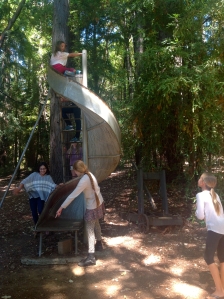 10:00-10:10 Welcome and Announcements
10:00-10:10 Welcome and Announcements
10:10-11:00 Instrumental Class, Part I
11:00-11:15 Recess
11:15-12:00 Instrumental Class, Part II
12:00-1:00 Lunch and Recess
1:00-2:00 Orchestra
2:00-3:00 Recess, including swimming if you feel like it
3:00-4:00 Recess/parents pick up at some point in this timeframe
Added up, students had about half the day free.
As you can probably tell from the kids’ comments in their interviews with me, a great deal of that time was spent in an exuberant exploration of the campus itself. For as long as most campers can remember, Kid Camp has been at Boomeria, a kind of place that is awesome enough for adults that it must be just about unbearably so for children.
The owner and creator of Boomeria, a certain Mr. Preston Q. Boomer (who prefers to be called Boom), only recently retired after a nearly 60-year career teaching high school physics and chemistry. He’d have his students come to his house and work on building projects that had science connections.
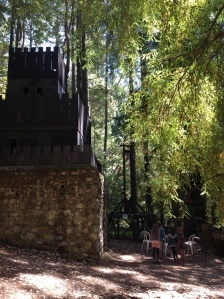 So there’s a castle, complete with a throne room, secret passageways, and a dungeon. Underneath the castle is an extensive network of catacombs, all of which were hand-dug by high school students holding shovels and buckets.
So there’s a castle, complete with a throne room, secret passageways, and a dungeon. Underneath the castle is an extensive network of catacombs, all of which were hand-dug by high school students holding shovels and buckets.
There’s a chapel with two pipe organs in it, rescued from churches that ‘upgraded’ to electronics. Boom hosts an annual Christmas carol party where, while they sing, his guests can read about the physics of sound waves thanks to helpful posters on the walls.
His playground equipment is vintage – unlike today’s carousels, which have floors and speed limits, Boom’s carousel is bottomless and can go just as fast as you can push it. (The children’s response? Challenge accepted. We kept a TA there to enforce safety rules. Let me tell you, camp manager Brianna Ady was formidable.)
And, of course, there’s a swimming pool. Boom, whose feisty spirit was summed up for me in a newspaper article which quoted him as referring to faculty meetings as “poolings of ignorance,” seemed to take a special delight in starting the fountain that rained down on kids in the middle of the pool. (It helped that there was a horn that heralded the jet of water with an especially loud aahuugah sound.)
 At lunch, I found myself welcomed by a group of 11-year-olds who apparently hadn’t gotten the memo sent from my classmates when I was that age that I was definitely not one of the cool kids. (The 11-year-old inside of me held her breath, sure they’d figure it out eventually and uninvite me, but it never happened.) So I got to be a part of their impassioned debates about their favorite YA novels and whether the movies captured the spirit of the books they loved (consensus: no). We also spent quite a bit of time playing Guess a Number, a game which seemed arbitrary to me but which commanded surprisingly continued interest as the days went on.
At lunch, I found myself welcomed by a group of 11-year-olds who apparently hadn’t gotten the memo sent from my classmates when I was that age that I was definitely not one of the cool kids. (The 11-year-old inside of me held her breath, sure they’d figure it out eventually and uninvite me, but it never happened.) So I got to be a part of their impassioned debates about their favorite YA novels and whether the movies captured the spirit of the books they loved (consensus: no). We also spent quite a bit of time playing Guess a Number, a game which seemed arbitrary to me but which commanded surprisingly continued interest as the days went on.
We loved the cats who wandered through the camp, Orange and Gray, as well as the dog, whose name we couldn’t remember but who quickly acquired a moniker of Burrito. I found myself reflecting on how there’s something endearing about a place where you can have a cat curled on your lap during orchestra practice.
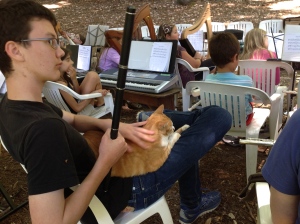 In short, these hours passed in a happy blur for students and teachers alike.
In short, these hours passed in a happy blur for students and teachers alike.
Still, even with all this joy around me, I was uneasy. We loved what we were doing, but would parents think this was worth their children’s time?
I found myself remembering how, in a previous life, when I used to direct the school programs at a museum, I once fielded a complaint call from a teacher who was upset that her students had spent 5 minutes in a hallway while two groups switched places between the gallery tour and classroom activity components of their program. “My feedback for you is that the children need to be learning all the time,” she said to me. (My response, that the children were learning how not to need adults to engage them at all times, may not have won any customer service points, but I do maintain it was the most educationally accurate position…)
Which is what I’m thinking about right now. It seems to me that in many educational spaces today there’s a worry about unstructured time – “making every moment count” seems to mean “making every moment structured.” We’re anxious about a competitive adult world and want kids to use their time to fill their adolescent CV with accolades that will endear them to colleges. On a deeper level, I’d suggest that we’re distrustful of children’s ability to make their own decisions.
This is a big topic lately. There’s been lots of reporting on how children have “lost the right to roam” and are subjected to nearly constant supervision, which means a loss in the kind of learning that comes with risk-taking and developing independence. We’re starting to recognize that giving our children “everything” (all that constant, structured engagement by friendly educators like me!) might also mean depriving them of experiences that build essential skills. I’m reminded of a recent article summarizing research about how college students are experiencing high rates of depression in part because they’re so unaccustomed to making their own decisions and so accustomed to being protected from failure.
But there are experts and then there are experts. So again, I turned to the kids. I got a lot of indignant, “Well, I don’t agree with that at all!” responses to my question, “What would you say to somebody who would say, oh, there shouldn’t be so much break time, because you have to be learning?”
One 12-year-old explained, “Well, that’s wrong! Because if you didn’t have enough breaks, the children will probably get really bored and not pay attention enough. Because most of the kids know that if we do the work really well, after the work, we get play and fun time.” (Not surprisingly, plenty of research backs her up…)
My favorite conversation was this one, with 8- and 9-year-old girls who had discovered a cicada:
“We found this cicada, and it’s like a big bug. It looks like a gigantic fly.”
“And when it chirps, it sounds electric, kind of. It’s weird.”
“And you can usually hear it at night. And it usually stays at the same place. It doesn’t go around a lot.”
– So the cicada was something you found while you were exploring. What’s recess like at Kid Camp?
“It’s fun and the merry-go-round is pretty fun.”
– Is it like recess at school?
“No. It’s more free, and you can do more of what you want.”
“Yeah, yeah.”
– What does recess feel like at school?
“Recess at school feels more strict, like, you can’t do this and you can’t do that.”
“Yeah, and there’s not that much oldish fun things. Like it’s all pretty new.”
“And like this [demonstrating] is how fast you could go, you couldn’t go any faster.”
– Some people would say that they’d be scared that kids would get hurt. What would you tell those people?
“That I don’t think you should be scared, because it’s not that dangerous.”
“It can only be dangerous if you’re doing crazy stuff.”
– So you have to learn to be responsible, right?
“Yeah.”
“Also, the other thing you can do at recess is that you can go in the castle. And that’s really fun.”
Golden. A good Reggio Emilia educator could build on the girls’ observations of the cicada to strengthen their knowledge of science, and I’m sure a Montessori person would want to point out the sense of self-agency, responsibility, and discovery that’s threaded throughout their comments.
My moment of realization came when I talked with a 10-year-old who told me about how he’d been using his recesses to try to memorize the castle.
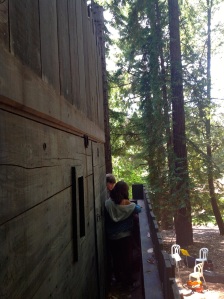 It struck me: as an adult, when I “explored” the castle, I went in, got a sense for what it was like, crawled through one of the narrow passageways, and then figured I knew what it was all about.
It struck me: as an adult, when I “explored” the castle, I went in, got a sense for what it was like, crawled through one of the narrow passageways, and then figured I knew what it was all about.
Not so.
For my 10-year-old guide, the castle was something to cherish in its own right. Exploring the castle was an ever-unfolding, always-unfinished project: there would always be a deeper knowledge to reach for, and the reaching was done not for some external reward but out of an appreciation of its own intrinsic value.
While I might have (mis)perceived him to be just running around, he was engaged in a purposeful pursuit that whole time. (And honestly, I couldn’t imagine a better transferable lesson for music, since you’re never done learning an instrument and it’s the sort of practice you have to return to with new curiosity each day.)
So now I think about how a 7-year-old asked me “What’s Kid Camp?” when I asked him what he thought about his experience this week – it was as though our shared days there were so obviously present that he wondered why you’d need a name for it, like a fish asking why you’d need a word for water.
He was the one to tell me how kids always did more fun stuff than adults.
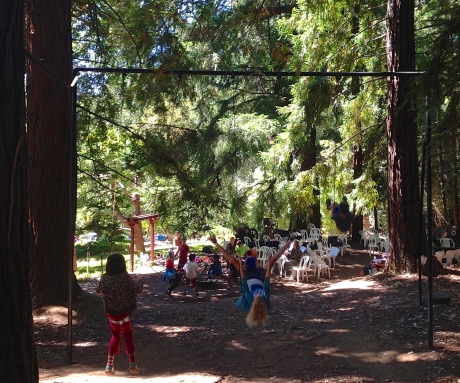 So – while I don’t know all what the campers learned that week, though I am confident it was many-faceted – here’s what I learned. Maybe what we need as adults is to learn to be more like kids:
So – while I don’t know all what the campers learned that week, though I am confident it was many-faceted – here’s what I learned. Maybe what we need as adults is to learn to be more like kids:
Less preoccupied with what we are “officially” doing, and more engaged with the totality of what we’re actually experiencing.
Less worried about measuring results, and more interested in mapping the inside of castles.
More excited to push a merry-go-round as fast as humanly possible.
More curious about the electric chirp of a cicada.
More open to the potential magic of every moment we share with each other…

